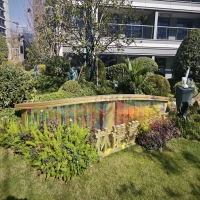Welcome to the website for landscape facilities products and knowledge.
What are the best practices for selecting a trash can in areas with high levels of airborne salt?
Living in coastal or high-salt environments requires careful consideration when selecting outdoor trash cans. Airborne salt accelerates corrosion, leading to rust and deterioration. Here are the best practices for choosing a durable trash can in such areas:
1. Material Matters: Opt for salt-resistant materials like marine-grade stainless steel, heavy-duty plastic (HDPE), or powder-coated aluminum. These materials withstand salt exposure better than standard metals.
2. Corrosion-Proof Coatings: Look for trash cans with anti-corrosion coatings or galvanized finishes. These add an extra layer of protection against salt damage.
3. Drainage Design: Choose bins with drainage holes to prevent water accumulation, which can trap salt and speed up rusting.
4. UV Resistance: Coastal areas often have strong sunlight. Ensure the trash can is UV-stabilized to prevent fading or brittleness.
5. Secure Lids: Tight-fitting lids protect against salt-laden winds and prevent debris from scattering.
6. Easy Maintenance: Select bins with smooth surfaces for easy cleaning, reducing salt buildup.
By prioritizing these features, you can extend the lifespan of your trash can in salty environments while maintaining functionality and aesthetics.
Related search:

Recommendation
Metal and acrylic color-changing combined curtain wall for large-scale public landscape facilities